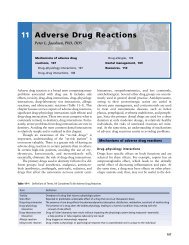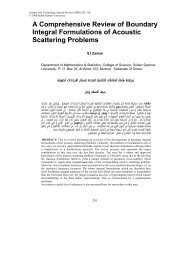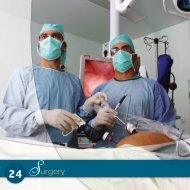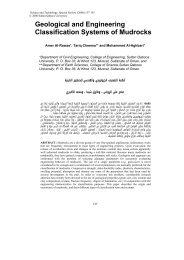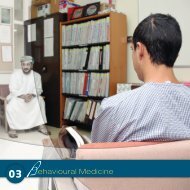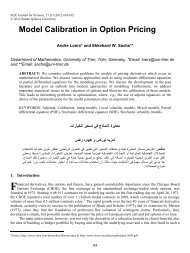81. Neonatal Hypotonia
81. Neonatal Hypotonia
81. Neonatal Hypotonia
- No tags were found...
Create successful ePaper yourself
Turn your PDF publications into a flip-book with our unique Google optimized e-Paper software.
<strong>Neonatal</strong> <strong>Hypotonia</strong> / 531TABLE 81-3.<strong>Hypotonia</strong>Clinical Features of Cerebral and PeripheralCerebralPeripheralClinical Feature <strong>Hypotonia</strong> <strong>Hypotonia</strong>Other abnormal brain function +++ ± (variable)Malformation of other organs + –Tendon reflexes Brisk or normal Decreased or absentPostural reflexes Preserved AbsentFisting of hands + –Fasciculations – ±Facial weakness – VariableLimb weakness ± +++– = feature may be absent; ± = feature variable (may be present or absent); + =feature is present; +++ = major feature (strongly present).A battery of laboratory investigations (eg, serum creatinekinase [CK], cerebrospinal fluid [CSF] analysis, nerveconduction studies and electromyography, neostigmine oredrophonium test, and muscle or sural nerve biopsy) maybe performed to determine the precise level of the pathologicalprocess affecting the motor unit. The greatestadvances in recent years have been made in moleculargenetic testing, which in many instances have obviatedmore invasive investigations.Specific aspects of these investigations relevant to newbornsrequire clarification to avoid pitfalls in the interpretationof results. Thus, elevated levels of serum concentrationsof CK generally imply skeletal or cardiac musclenecrosis, as may occur in rapidly progressive muscular dystrophiesand metabolic myopathies. The blood for CKmeasurement should be obtained before performing theelectromyography or muscle biopsy, as these proceduresmay cause false elevation of CK levels. The CK and isoenzymelevels may be increased 10-fold for up to 1 week followingnormal vaginal delivery (presumably due to muscletrauma). The CK may be even higher in the context ofacidosis (eg, severely asphyxiated newborns). Other biochemicalinvestigations (eg, serum lactate and carnitinelevels) may be required in specific circumstances.A chest radiograph may demonstrate enlarged cardiacsilhouette signifying cardiomyopathy or thin ribs, presumablyrelated to diminished fetal respiratory movements. Thelatter observation is a useful clue to antenatal onset of neuromusculardisease. Markedly increased protein concentrationin CSF may indicate peripheral neuropathy or specificdegenerative conditions (eg, Krabbe’s disease).Nerve conduction studies are consistent and reliableafter 32 weeks of gestation. Nerve conduction velocities,which are slower in normal newborns than in older individuals,may be very slow or unrecordable in the context ofcongenital peripheral neuropathies. The technical performanceand interpretation of the electromyogram (EMG)may be problematic in the newborn. For example, myotonicdischarges, which occur in older individuals with myotonicdystrophy, are rarely elicited in the newborn. Muscle biopsy(either by open surgical technique or needle biopsy) is technicallyfeasible in the newborn. Early biopsy may berequired if there is severe respiratory muscle involvementto provide definitive diagnosis and prognosis to assist managementdecisions. Otherwise, muscle biopsy is often postponedfor several months. In some instances (eg, congenitalmuscular dystrophy), repeated muscle biopsies may beuseful for establishing an accurate diagnosis.Major Disorders Associated withCerebral <strong>Hypotonia</strong><strong>Hypotonia</strong> is a feature of almost every cerebral disorder innewborns and older infants. In many instances, other presentingsymptoms or signs (eg, seizures, intracranial hemorrhage,trauma, and decreased level of consciousness associatedwith moderate or severe hypoxic-ischemicencephalopathy) suggest the most probable underlying diagnosis.However, other disorders may have few clinical featuresother than hypotonia, which may lead to a mistakendiagnosis of disease involving the motor unit. The mostcommon of these latter conditions are listed in Table 81-4and will be discussed briefly as follows.Brain and Spinal Cord Injuryor TraumaModerate or severe acute hypoxic-ischemic encephalopathyis usually suspected on the basis of clinical indicatorsof intrapartum hypoxic-ischemic insult in concert withpostnatal features of encephalopathy (eg, decreased level ofconsciousness or seizures). Intracranial hemorrhage maybe associated with seizures, anemia, and raised intracranialpressure. Cervical spinal cord injury, although uncommon,may be related to traction forces during vaginal delivery,especially in the context of difficult forceps delivery orbreech presentation. In such circumstances, the newborninfant is often flaccid, with absent spontaneous respirations.When infants are conscious, there may be evidenceof preserved cranial nerve function. Tendon reflexes maybe absent initially but become exaggerated later. The bladdermay be distended with overflow incontinence.Genetic and Chromosomal DisordersDown syndrome, the most common chromosomal disorderassociated with neonatal hypotonia, should be easily recognizable.Prader-Willi syndrome is associated with deletionsor translocations of the chromosome 15q11-13 region, andmost commonly, the abnormal chromosome is contributedby the father, although inheritance of both copies of chro-Current Management in Child Neurology, Third Edition© 2005 Bernard L. Maria, All Rights Reserved <strong>Neonatal</strong> <strong>Hypotonia</strong>BC Decker Inc Pages 528–534






